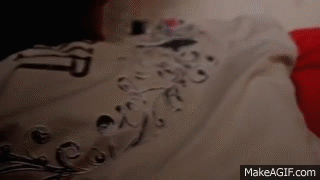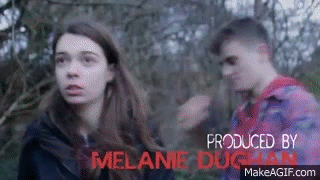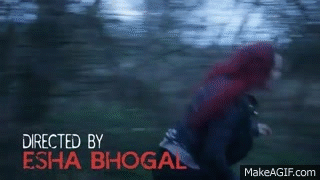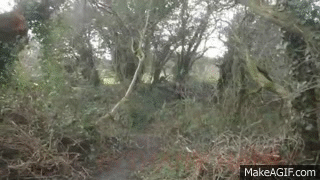Wednesday, 6 May 2015
5) How did you attract/address your audience?
In my final piece I use a variety of techniques to attract my audience. There are many moments of suspense and unanswered questions which were designed to draw in the audience and allow them to piece together the narrative.
The piece begins with foreboding music, immediately setting the tone as a mysterious and potentially dangerous one. As the protagonist sleeps, there are two flashbacks at 0:22 and 0:24, with the suggestion that this is what the character is dreaming about, as she wriggles around in her sleep and jerks awake at 0:28. This also acts as a foreshadow for the antagonist, leaving the audience wandering who he is and what connection he has to the main character.
The foreboding soundtrack also ceases at 0:28, coinciding with the character jerking back to reality. However. normality does not last long, as at 0:47 the audience sees the ghost for the first time. The soundtrack fades in once more, and the audience are left wandering who this character is, and why the protagonist does not notice them.
The whole conversational scene that follows, with dialogue lasting between 0:58 to 1:19, is also very ambiguous, with hints of knowledge that the audience do not know, but perhaps will be revealed to them over the course of the film. The main character is asked the question, 'How have you been since-?', hinting at a past traumatic event that will affect the current narrative. She is also hesitant to expose her current whereabouts after she had 'moved out', stating simply 'just a small rural town'. This is sometimes a convention of a reclusive character, out of touch with mainstream society. This theory can be backed up with the protagonist's startled reaction to her old friend, with the suggestion that they some time has passed from their last meeting, perhaps due to this suggested past event and the fact that she had 'moved out'. There is also the suggestion that the protagonist has temporarily returned to this original location, perhaps to help her confront her troubles. This can be supported by the remorseful and empty way she looks out into the world at 0:53, perhaps remembering the time that she spent here. That would also explain why she had just bumped into her friend and later on, why the antagonist also catches up with her. All of this hinted activity before the events of the film attract the audience as it invites them to imagine the possibilities and how this affect the current narrative. It may also act as foreshadowing if these events are explained further on in the film.
At 0:16, the screen cuts to black and the audience hear a diegetic scream. The events that lead up to this scream are undisclosed, again leaving the audience in the dark about the exact details of what they are experiencing. The scream is also quite sudden, and this shock factor, or the ability to 'thrill' is popular in attracting thriller audiences
A slow pan at 1:48 reveals the antagonist, previously only seen in a flashback/dream sequence. This was seen by the other character, suggesting that the current character in screen is not familiar with the antagonist. This also suggests that her implied death moments later is through no fault of her own. The slow pan creates tension, and draws in the audiences' attention. As the antagonist approaches, the foreboding music abruptly stops and only a heartbeat can be heard, which represents the killer's adrenaline, the victim's fear and exhaustion and the audiences' tension. Fast editing is also used in this small sequences, adding to the heightened tension of the scene. A similar technique is used as a transition, as the screen once again cuts to black at 2:00, sparing the audience the gory details of the character's implied death, as the heartbeat is also instantaneously cut at this moment. This can also contribute to lowering the age rating of the film to accommodate a wider audience. However there are also suggestions of a comeback for the character, as she may be subjected to a fate such as the ghost seen nearer the beginning of the clip.
Once this sequence has finished, the audience return back to the protagonist at 2:01, who stops for a breath just like her friend. However at 2:07, both her and the audience hear the diegetic sound of snapping a branch, alerting her of the presence of another person. It is heavily implied that it is the antagonist and that perhaps they will have a confrontation of sorts. The title card appears at 2:09, cutting this scene short. The audience, after being startled by the branch snapping, and now left to wander the outcome of the presented situation, creating intrigue, hopefully strong enough to compel audience members to watch on.
The piece does not address the audience directly, as it is unconventional for films to break the forth wall. However there are other more indirect ways that my films achieves this. One way is through representation, as there are both male and female characters in the piece, as well as an ethnic minority. The piece ranges a cast from 7 to 18 years old, but does not go beyond young people. Through my audience research I concluded that a lot of young people watch thriller films and make up a considerable part of the overall audience, and so addressing them through representation can also attract them to the piece.
The piece begins with foreboding music, immediately setting the tone as a mysterious and potentially dangerous one. As the protagonist sleeps, there are two flashbacks at 0:22 and 0:24, with the suggestion that this is what the character is dreaming about, as she wriggles around in her sleep and jerks awake at 0:28. This also acts as a foreshadow for the antagonist, leaving the audience wandering who he is and what connection he has to the main character.
The foreboding soundtrack also ceases at 0:28, coinciding with the character jerking back to reality. However. normality does not last long, as at 0:47 the audience sees the ghost for the first time. The soundtrack fades in once more, and the audience are left wandering who this character is, and why the protagonist does not notice them.
The whole conversational scene that follows, with dialogue lasting between 0:58 to 1:19, is also very ambiguous, with hints of knowledge that the audience do not know, but perhaps will be revealed to them over the course of the film. The main character is asked the question, 'How have you been since-?', hinting at a past traumatic event that will affect the current narrative. She is also hesitant to expose her current whereabouts after she had 'moved out', stating simply 'just a small rural town'. This is sometimes a convention of a reclusive character, out of touch with mainstream society. This theory can be backed up with the protagonist's startled reaction to her old friend, with the suggestion that they some time has passed from their last meeting, perhaps due to this suggested past event and the fact that she had 'moved out'. There is also the suggestion that the protagonist has temporarily returned to this original location, perhaps to help her confront her troubles. This can be supported by the remorseful and empty way she looks out into the world at 0:53, perhaps remembering the time that she spent here. That would also explain why she had just bumped into her friend and later on, why the antagonist also catches up with her. All of this hinted activity before the events of the film attract the audience as it invites them to imagine the possibilities and how this affect the current narrative. It may also act as foreshadowing if these events are explained further on in the film.
At 0:16, the screen cuts to black and the audience hear a diegetic scream. The events that lead up to this scream are undisclosed, again leaving the audience in the dark about the exact details of what they are experiencing. The scream is also quite sudden, and this shock factor, or the ability to 'thrill' is popular in attracting thriller audiences
A slow pan at 1:48 reveals the antagonist, previously only seen in a flashback/dream sequence. This was seen by the other character, suggesting that the current character in screen is not familiar with the antagonist. This also suggests that her implied death moments later is through no fault of her own. The slow pan creates tension, and draws in the audiences' attention. As the antagonist approaches, the foreboding music abruptly stops and only a heartbeat can be heard, which represents the killer's adrenaline, the victim's fear and exhaustion and the audiences' tension. Fast editing is also used in this small sequences, adding to the heightened tension of the scene. A similar technique is used as a transition, as the screen once again cuts to black at 2:00, sparing the audience the gory details of the character's implied death, as the heartbeat is also instantaneously cut at this moment. This can also contribute to lowering the age rating of the film to accommodate a wider audience. However there are also suggestions of a comeback for the character, as she may be subjected to a fate such as the ghost seen nearer the beginning of the clip.
Once this sequence has finished, the audience return back to the protagonist at 2:01, who stops for a breath just like her friend. However at 2:07, both her and the audience hear the diegetic sound of snapping a branch, alerting her of the presence of another person. It is heavily implied that it is the antagonist and that perhaps they will have a confrontation of sorts. The title card appears at 2:09, cutting this scene short. The audience, after being startled by the branch snapping, and now left to wander the outcome of the presented situation, creating intrigue, hopefully strong enough to compel audience members to watch on.
The piece does not address the audience directly, as it is unconventional for films to break the forth wall. However there are other more indirect ways that my films achieves this. One way is through representation, as there are both male and female characters in the piece, as well as an ethnic minority. The piece ranges a cast from 7 to 18 years old, but does not go beyond young people. Through my audience research I concluded that a lot of young people watch thriller films and make up a considerable part of the overall audience, and so addressing them through representation can also attract them to the piece.
2) How does your media product represent particular social groups?
Transcript:
My film features young people, ranging from 7 to 18 years old. I did this as from my research I discovered that the typical audience for thriller films are teenagers to young adults. This mould fits most of my cast and for this reason the audience can relate and empathise with the characters.
Costume and make-up was also carefully considered. Costume for the murderer included checked shirts and lots of layers to appear rugged and mismatched. Checked shirts have become something of a stereotype and a conventions when portraying homeless or on the run characters. For make-up brown eye shadow was applied on his face to appear like dirt and his facial hair was emphasised with black mascara, in order to look more prominent on camera. This again was done to add to the rugged appearance and to give the impression that he was rough and experiencing problems. The victim was dressed in casual looking clothes, appropriate for the weather. She was in a jumper and light colours, suggesting innocence and perhaps naivety. Her make-up was minimal and natural looking to create the illusion of everyday life and also to make her seem more vulnerable and not aggressive. On the other hand the main character was dressed in darker colours and a leather jacket. This suggests that her character is tougher and stronger and therefore more able to escape the situation. Her make-up in heavier too, although still acceptable for everyday. This is to contribute to the tougher character portrayal. The little boy ghost was dressed in casual clothing consisting of a jumper and jeans. This was to make him appear harmless and merely a observer rather than another antagonist.
Teenagers and young adults are represented as most of the cast fit into this category. Genders are also represented, as there are two female and two male characters. Genders are stereotyped in my piece, as the antagonist is a dominant male character and the victim a female. The protagonist could be a countertype, dependent on the events of the rest of the film. Although she is being stalked and victimised by this male antagonist, she is clearly tougher than her other female friend. A different ethnic group is also featured through the ghost.
1) In what ways does your media product use, develop or challenge forms and conventions of real media products?
My media product includes many different types of conventions that I had previously researched before constructing my own. I have tried to use as many as I can to embrace the thriller genre and in order to apply information I had learnt during my research into thriller films.
In terms of camera work I have used a variety of shots. This was to help the editing process later, to create a fast pace, and to take advantage of my actors and locations. One shot I was keen to use was a handheld shot.
This can create a feeling on urgency and panic. I also used close-ups to emphasise emotions and to only have one actor's face in frame and therefore not allow the audience to see outside of this and build suspense.
Another shot I used was a pan when first introducing the murderer. This pan was slow to draw the attention of the viewer and acted as an establishing shot for this character.
Low angles were used when shooting a close-up of the villain's face, to portray him as an intimidating and, in the current situation, powerful character.
I incorporated some editing conventions too. Towards the start of my opening sequence the pace of the clip is slow. Later once the tension has risen straight cuts are made more often and this is done to add to the build up.
Dissolves are used in between clips where it is suggested that considerable time has passed.
Dips to black are added too, in between production companies and at the start and end, to make the sequence seem more professional. A couple of black screens are incorporated to suggest certain events, aided by sound, as opposed to representing them visually.
For sound I attempted to insert both diegetic and non-diegetic sound. Thrillers usually use orchestral music with strong drum beats and this is what I tried to do. The music tracks I selected sounded tense and foreboding, perfect for a mysterious thriller. Usually quiet sounds are also amplified to emphasise the silence otherwise present and the heightened senses of the actor(s) in a current situation. I did this with heartbeat and branch snapping sounds.
I also tried to follow the conventions of mise-en-scene. I used redhead lighting for my interior shots and at certain points a reflector or a diffuser. I tried to create soft lighting, dim but bright enough to see the shot clearly. I planned to create a darker looking shot when in the editing stage.
Although I had little control over my outside shots due to weather I tried to film as much as possible during daylight hours to maximise my chances. Low key lighting is a convention of thriller films and my film does become darker and more mysterious towards the end.
For props I was initially going to use a gun, as this is also a common convention amongst films of this genre, however due to various circumstances I could not source one for the day I was filming. Instead of a gun I used a sharp looking rock. This was more in line with my character, who is homeless and unhinged and for this reason it would make more sense for him to utilise the environment.
My setting is very typical of a thriller film as it is set in a forest area.
This creates a sense of isolation and being lost. It allows the characters to run aimlessly and for the villain to appear unexpectedly. The bedroom and kitchen scenes at the beginning add a sense of normality to the sequence, almost the calm before the storm. Even then there are hints of disaster early on due to the flashbacks the protagonist has in her dream and the ghost.
The themes included in my opening sequence could include murder, mystery, ghosts, revenge and stalking. These are all conventions of thriller films, even if they span over wide sub-genres. My narrative also includes such aspects and more, such as having flashback or bad dreams and running away from something.
Subscribe to:
Posts (Atom)







